Top 5 best dehydrator for herbs – Make Your Own Herbal Teas, Dried Fruits, and More!
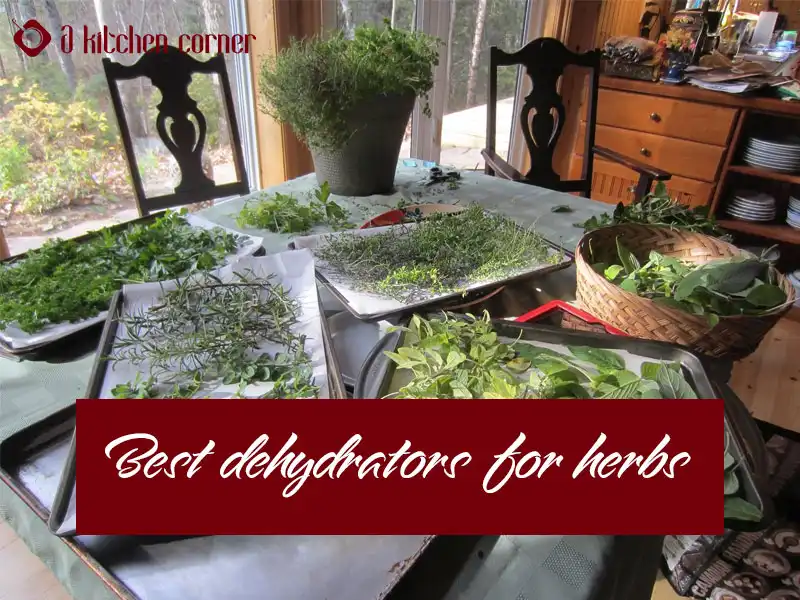
Dried herbs and herbal teas don’t have to cost a fortune; you can preserve them at home using a food dehydrator for a fraction of the price. Compared to store brands, they will taste better and be healthier, and the preparation is simple.
Let’s now look at how the best dehydrator for herbs can help you save money and maintain your dedication to a healthy diet.
Contents
- 1 Overview
- 2 Types of dehydrators
- 3 Top 5 best dehydrator for herbs reviews
- 3.1 Best Stackable Herb Dehydrator: COSORI Food Dehydrator Machine
- 3.2 Best Box-Type Herb Dehydrator: COSORI Premium Food Dehydrator Machine
- 3.3 Best Portable Option: Brod & Taylor SAHARA Folding Food Dehydrator
- 3.4 Best Budget Option: Presto Dehydro Electric Food Dehydrator
- 3.5 Best Large Food Dehydrator: STX International Dehydra Commercial Grade Stainless Steel Digital Food Dehydrator
- 4 What to look for in the best food dehydrator for herbs?
- 5 How to Dry Herbs With a Food Dehydrator?
- 6 How to store dehydrated herbs?
- 7 FAQs
Overview
Looking for the best dehydrator for herbs? In this blog, we’ve compiled a list of the top 5 dehydrators to help you make an informed choice. Whether you’re looking for a stackable option, a box-type dehydrator, or a portable one, we’ve got you covered. Here are our top picks:
- Best Stackable Herb Dehydrator: COSORI Food Dehydrator Machine
- Best Box-Type Herb Dehydrator: COSORI Premium Food Dehydrator Machine
- Best Portable Option: Brod & Taylor SAHARA Folding Food Dehydrator
- Best Budget Option: Presto Dehydro Electric Food Dehydrator
- Best Large Food Dehydrator: STX International Dehydra Commercial Grade Stainless Steel Digital Food Dehydrator
If you’re interested in learning more about these top dehydrators for herbs, keep reading for an in-depth review of each product.
Types of dehydrators
Many different “dehydrators” are available on the market; some even consist of a straightforward mesh screen that naturally dehydrates herbs without inviting pests. To recommend you the best dehydrator for herbs, our reviews focus on electric dehydrators that dry the herbs by convection and fans.
Food dehydrators come in two main types.
- Stackable (Or vertical dehydrators)
- Box-and-shelf (Or horizontal dehydrators)
Stackable dehydrators
Stackable dehydrators frequently have spherical trays that fit on top of one another. Food dries uniformly thanks to a fan installed above or below the trays that drive hot air via a central channel and distributes it equally across each.
Pros
- They are reasonably priced.
- Small in size and doesn’t take up much room.
- It can be increased by adding more trays to the stack.
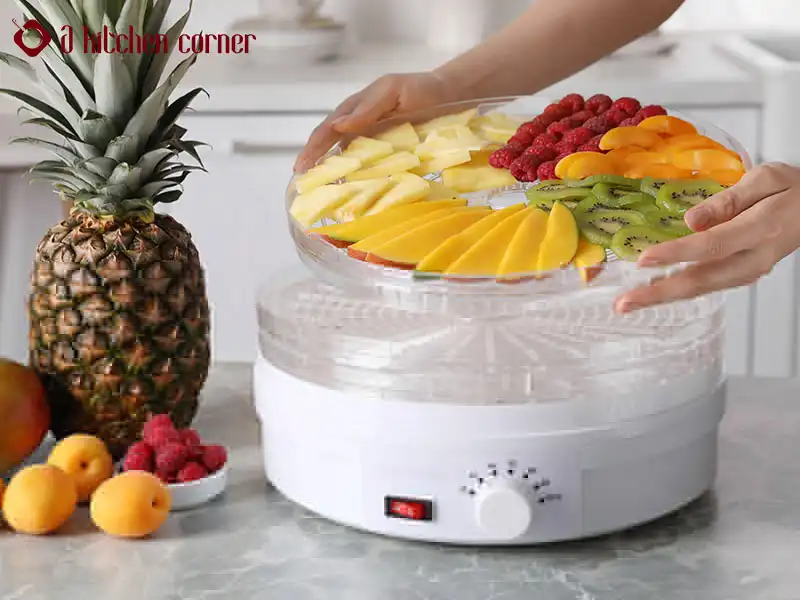
Stackable dehydrators frequently have spherical trays
Box-and-shelf
These models are usually more expensive but require less attention during the drying process. Layer trays pull out from a central box via a front access door. A fan in the back of the unit distributes air more evenly across the trays than the bottom-level fan of stackable units. These box and shelf units allow all levels to receive the same airflow while dehydrating.
In other words, when using box-and-shelf dehydrators, you do not need to swap the bottom tray for the top tray.
Pros
- Evenly heating.
- Easy to use.
- It can dehydrate more complex food items.
Top 5 best dehydrator for herbs reviews
Our top 7 picks for the best dehydrator for herbs are listed below. We have included various types of units in various sizes, types, and price ranges so that you can select the model that best meets your needs.
Best Stackable Herb Dehydrator: COSORI Food Dehydrator Machine
Drying herbs is a breeze with this high-quality stackable dehydrator. The kits include five BPA-free trays and a fruit roll sheet for making nutritious leather. Strawberry and basil is a kid-friendly flavor combination.
Among the features are four hundred fifty watts of drying power, an easy-to-use control panel, a 48-hour digital timer with a memory function, and overheat protection. It expands to seven trays and disassembles in seconds for easy cleaning — the trays and lid are dishwasher-safe.
The 13-inch footprint saves space in a studio apartment but may be insufficient for drying large quantities. There is no simpler or more convenient best dehydrator for herbs on the market for small batches.
- Excellent value for money
- Simple to use and clean
- Lightweight and portable
- It has a timer and is safe to use
Cons
- Over time, the plastic trays and cover may break.
- There is only one fruit tray included.
Best Box-Type Herb Dehydrator: COSORI Premium Food Dehydrator Machine
With the COSORI premium food dehydrator, you can dry savory herbs in your kitchen for a fraction of the retail price. The small box-style design houses a 600-watt heater and fan for quick but gentle heating.
This best dehydrator for herbs has six dishwasher-safe stainless steel shelves holding up to three pounds of herbs, five pounds of jerky, or eight pounds of fruit while drying. It’s easy to use, whisper-quiet, and safe, and comes with a 48-hour digital timer with automatic shut-off. If the dehydrator overheats, the overheat protection shuts it down.
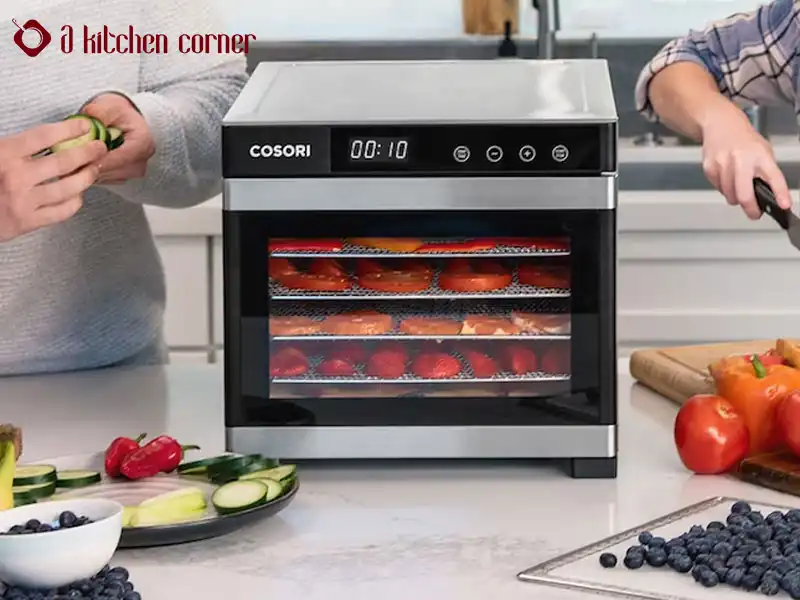
#2 Best dehydrator for herbs – COSORI Premium Food Dehydrator Machine
The integrated handles make it easy to store if you’re short on counter space. Still, the stunning black and stainless steel cabinet exudes quality you’ll want everyone to see. This best dehydrator for herbs will exceed your expectations, whether you’re a beginner or an experienced herb enthusiast.
Pros
- Excellent drying capacity
- It includes a timer.
- Made of glass and stainless steel
- Elegant design
- Trays can be washed in the dishwasher
- Excellent safety features
Cons
- Includes only one fruit tray
Best Portable Option: Brod & Taylor SAHARA Folding Food Dehydrator
The award-winning folding best dehydrator for herbs from Brod & Taylors is ideal for nomads and small-space living, collapsing to 1/3 of its original size for easy storage and transport.
The stainless steel cabinet holds seven trays for a total drying area of 11 square feet. Dual 700-watt heaters are quiet and efficient, drying large amounts of material in record time. Two automated timer controls, one for each heater, provide up to 198 hours of continuous operation at temperatures ranging from 85 to 165 degrees Fahrenheit.
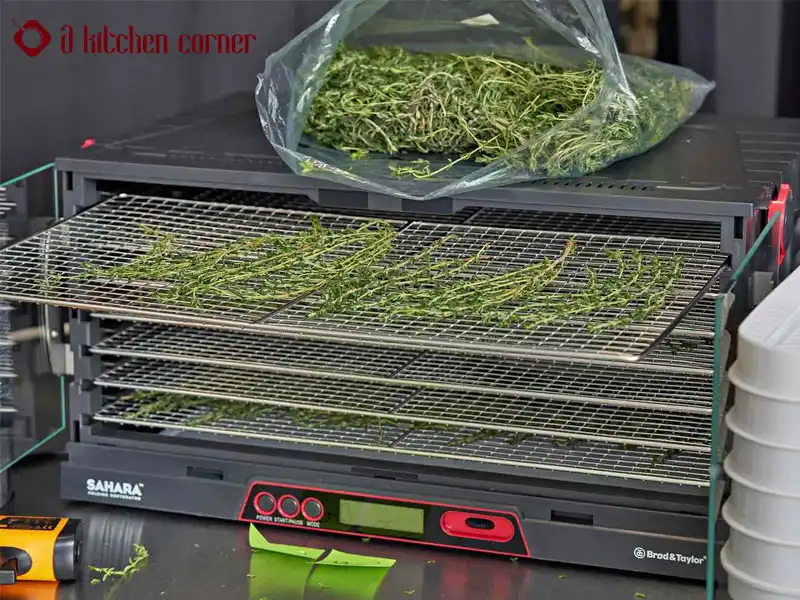
#3 Best dehydrator for herbs – Brod & Taylor SAHARA Folding Food Dehydrator
You can observe the drying process through clear glass doors while knowing it’s safe — Brod & Taylor dehydrators include a washable air filter to keep airborne contaminants out of your food. This model is not cheap, but if you want to dry large volumes in less space, you will not be disappointed.
Pros
- Large capacity for drying
- Outstanding overall quality
- Long-lasting construction
- Portable
- Dual timers and temperature control
- It comes with an air filter.
- A warranty period of three years
Cons
- Expensive
>> Related post: 5 Portable Mini Food Dehydrators To Purchase
Best Budget Option: Presto Dehydro Electric Food Dehydrator
The Presto electric food dehydrator is simple in design but powerful in performance. It is also reasonably priced and has a reasonable capacity.
It comes with four BPA-free trays and can be expanded to eight for large-volume drying. Trays nest to save space, and the cord tucks neatly inside.
Despite its low price, Presto manufactures a full line of Dehydro accessories, including nonstick mesh screens and silicone liners that prevent small herbs like rosemary from falling through the trays.
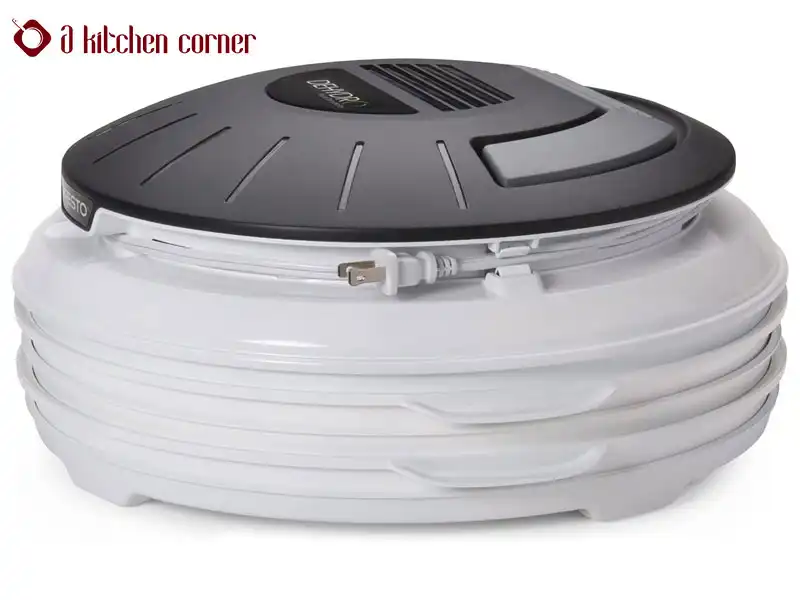
#4 Best dehydrator for herbs – Presto Dehydro Electric Food Dehydrator
Our only complaint is that it lacks a timer and an adjustable temperature control. When you plug it in, it consistently heats to 165 degrees, which is too hot for herbs.
Nonetheless, some users report satisfactory results with kitchen staples ranging from parsley to basil. Presto’s Dehydro electric food dehydrator demonstrates that good things can come in small packages.
Pros
- Affordable
- Design that is simple and compact
Cons
- It is simple to use.
- There is only one temperature setting that is too hot for herbs.
- There is no timer.
Best Large Food Dehydrator: STX International Dehydra Commercial Grade Stainless Steel Digital Food Dehydrator
STX’s commercial dehydrator can quickly stock your herb pantry. Ten 304-grade stainless steel trays provide 11 square feet of drying space for treats ranging from beef jerky to seasonings.
This dehydrator is massive, measuring 20 17.50 15 inches, and the powerful 1200-watt heater safely preserves large quantities of food. The Dehydra has a digital control panel, seven programmable temperature settings, a 15-hour timer, and an automatic shut-off to prevent food from drying. The removable drip tray makes cleanup a breeze.
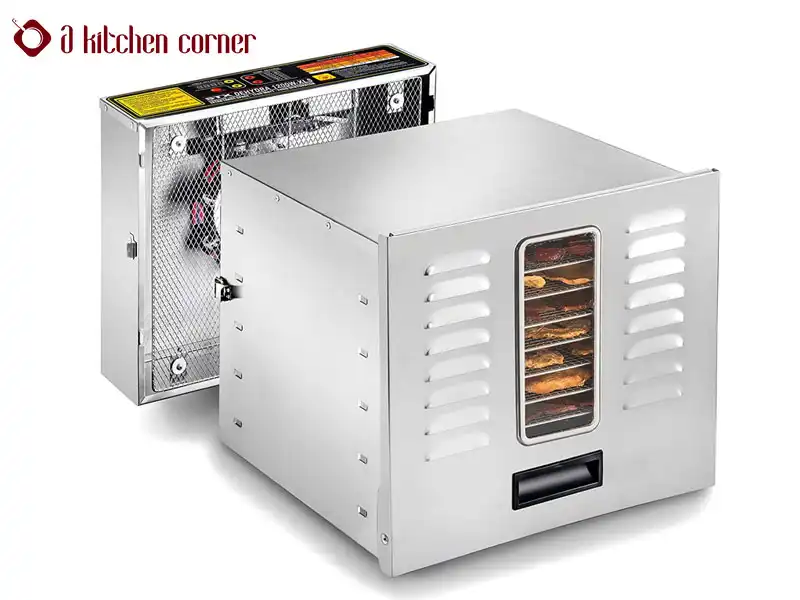
#5 Best dehydrator for herbs – STX International Dehydra
There are two minor flaws with this model. It has an industrial appearance, so it’s not something most people would want on their counter every day, and it’s a pain to move in and out of storage at 38 pounds. However, suppose you can locate it in a permanent location where its aesthetics will not detract from your décor. In that case, it’s a well-equipped, high-volume best dehydrator for herbs.
Pros
- Exceptional drying capacity
- A fantastic control panel with a timer.
- It disassembles for easy cleaning.
- Made from 304 stainless steel
- Excellent safety features
Cons
- Heavy
- Not very appealing.
What to look for in the best food dehydrator for herbs?
Drying herbs and other foods is a breeze with the best dehydrator for herbs. Consider how each of these characteristics contributes to our top picks being a good fit for your lifestyle.
Capacity
The capacity of a dehydrator is measured in square feet. Most miniature models have 3-4 square feet of drying space, while larger models have ten or more.
While 3-4 square feet sounds impressive, you’ll quickly run out of room if you dry in large quantities. Leafy herbs should be spaced at least an inch apart so air can flow freely.
The size of a dehydrator is also important to consider; the largest can take up to two square feet of counter space, so measure before you buy. Consider how much it weighs if you intend to store it in a closet when not in use. Models weighing forty pounds are challenging to move into and out of storage.
Temperature control
Better dehydrators have temperature controls to optimize drying for different foods.
Pros recommend dehydrating jerky at 155°F (68°C), but only herbs at 95°F (35°C). Temperatures above 115°F (46°C) will significantly reduce the aroma and valuable nutrients of the plants.
Models that heat at a single consistent temperature are adequate but not ideal. If the temperature is too low, the drying process will take longer and may not remove enough moisture to keep the meat from spoiling. It can burn tender herbs if it is too high.
Easy to use and maintenance
Dehydrators aren’t rocket science, but some are easier to use than others. Better models strike a balance between function and convenience.
Back-lit digital screens are worth the extra money for viewing in low-light conditions, and an automatic shut-off switch that shuts down the unit if it overheats. First and foremost, safety.
Maintaining a dehydrator is simple: keep it clean. Because herbs contain a high concentration of natural aromatic oils, a soap and water scrub after each use keeps plastic trays from absorbing odors. Dishwasher-safe trays are a bonus.
How to Dry Herbs With a Food Dehydrator?
With your best dehydrator for herbs, drying herbs and other foods is a breeze. Consider how each of these characteristics contributes to our top picks being a good fit for your lifestyle.
- Step 1: It is best to harvest the herbs in the early morning before it gets too hot. You can also use herbs from the grocery store.
- Step 2: Remove large stems and any damaged parts from the herbs before rinsing them carefully under running water. Remove any dirt or debris that may have accumulated on the surface of the leaves and stems. After that, gently dry the herbs between two sheets of paper or a clean towel.
- Step 3: Preheat the food dehydrator to 95 degrees Fahrenheit (35 degrees Celsius). Try higher temperatures if you live in an area with high air humidity, but they should not exceed 115°F (46°C).
- Step 4: Arrange the herbs in a single layer on the trays of your best dehydrator for herbs. Allow enough space for air to circulate them to ensure an efficient drying process.
- Step 5: While drying, keep an eye on the herbs. Depending on your dehydrator, air humidity, and the type of herbs you are drying, drying time can range from 4 to 12 hours.
- Step 6: When you can easily crumble the herbs with your fingers, and the stems snap when bent, they are done.
- Step 7: Allow the herbs to cool before removing the leaves from any remaining stems. Then, store them in airtight jars as whole leaves to best preserve them. Large pieces that are difficult to fit into jars can be gently rubbed between your palms or cut into smaller pieces. You can crush the herbs later before using them if you prefer.
How to store dehydrated herbs?
- Dried herbs should be totally cooled before being transferred. Before storage, separate the leaves from the stems.
- If you store the herbs whole rather than crumbled, their flavor will stay longer; for optimal results, do this just before using them.
- Keep in a spick-and-span, airtight container. Use vacuum sealing for a longer shelf life.
- If you’re going to be opening the container frequently or if you live in a humid climate, use a moisture-absorbing desiccant packet.
- The date, the herb’s name, and any other significant information should be written on the container’s label.
- Place the container in a cool, dark, and dry place.
FAQs
No. It is not necessary to purchase a “herb-specific” dehydrator. Most herbs dehydrate well at temperatures ranging from 95 to 115 degrees Fahrenheit, so selecting the best dehydrator for herbs will require some temperature flexibility.
Remember that the amount of moisture in the herbs determines how quickly they dry. Monitor your first few batches to decide which temperature works best for your herb selection and the natural environmental conditions in which the herbs were grown. Herbs grown in arid conditions may have less natural moisture.
When herbs have dried entirely, they will be crisp. Rub a leaf between your fingers to test them; it should easily crumble when they have cooled. Dry them for a little while longer if not.
Dehydrated herbs can last from six to twelve months when stored properly. Herbs that are vacuum-sealed will last much longer.
Herbs that have been dehydrated can be used in the same way as dried herbs purchased from a store. Use 1/3 the amount specified if using dried herbs instead of fresh ones because dried herbs’ flavor is more intense. Here are some suggestions for applying your dried herbs:
- Use with homemade pesto or chimichurri after rehydrating in warm water and draining.
- Add dried mint to the iced tea.
- Use marinades and rubs.
- Use meals for trekking and camping.
It is possible to dry a mixture of herbs simultaneously since their flavors will not merge.
However, it is important to note that some herbs possess more moisture than others, hence it is not advisable to blend different types on the same tray. For long-lasting flavor, it is best to keep the dried herbs as whole
Although dehydration does not significantly alter most nutrients, vitamins A and C may be diminished or eliminated. Additionally, depending on the dehydration method employed, B-vitamins and certain minerals may also be reduced.
There you have it! That’s all you need to get started dehydrating your herbs. Have you found the best dehydrator for herbs? How did things go? Tell us in the comments! If you have any questions, email us or give DM us on our fan page https://www.facebook.com/akitchencorner. Glad to hear from you!
You may be interested:



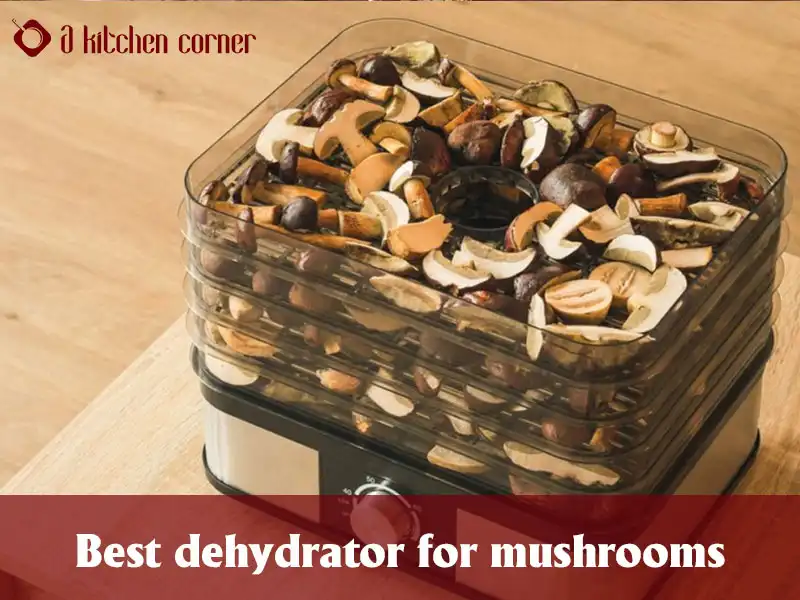






Hmm it looks like your site ate my first comment (it was super long) so I guess I’ll just sum it up what I wrote and say, I’m thoroughly enjoying your blog. I as well am an aspiring blog blogger but I’m still new to everything. Do you have any helpful hints for beginner blog writers? I’d genuinely appreciate it.
Thank you very much.
Hi, yup this piece of writing is in fact nice and I have learned lot of things from it on the topic of blogging. thanks.
Thanks, that’s so nice.